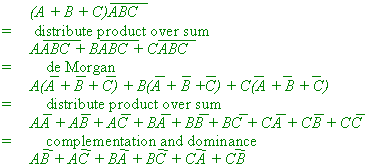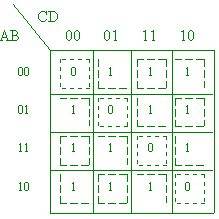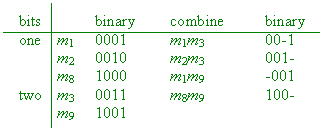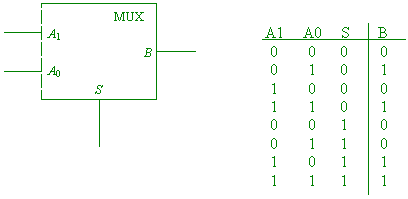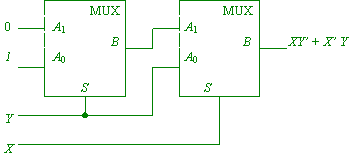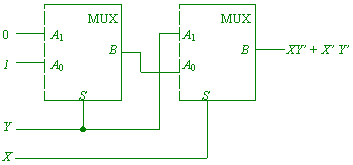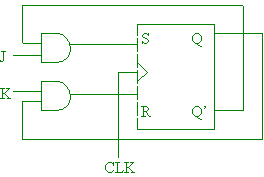|
(a) Convert the number
30.12510 into binary. [2 marks] (b) Calculate the value of the expression (11012 + 348 + F0516) ¸ 2 and express the result
in binary-coded decimal. [4 marks] (11012 + 348 + F0516) ¸ 2 = (D + 1C +F05)16 ¸ 2 = F2E16 ¸ 2 = 79716 = 7 X 162 + 9 ´ 16 + 7 = 194310 = 0001 1001 0100 001 1BCD (1 mark for converting everything correctly to a common base --- any base will do. 1 mark for correctly performing the addition. 1 mark for correctly performing the division. 1 mark for expressing the result in BCD.) [4 marks]
(c) Using the laws of boolean algebra, transform the expression
into a sum of products
in the simplest form possible. Identify the laws used. [5 marks]
(3 marks for a completely correct calculation to a sum of products, or failing complete correctness, 1 mark for each correct step to a maximum of 2 marks. 1 mark for getting the simplest possible form above. Final 1 mark for a reasonable attempt at identifying the laws used.) [5 marks]
(d) Find the simplified sum-of-product and product-of-sum forms of the function F(A, B, C, D) = Õ (0, 5, 10, 15) using a Karnaugh map. [4 marks]
The 1s are grouped with dots and the 0s with dashes – note that two groupings wrap around (1 mark for correct grouping of 1s, 1 mark for 0s), so the SOP form is AC’ + A’C + BD’ + B’D (1 mark) and the POS form is (A + B + C + D)(A + B’ + C + D’)(A’ + B + C’ + D)(A’ + B’ + C’ + D’) (1 mark). [4 marks] (e)Find the prime implicants of the expression
å (m1, m2, m3, m8, m9) using the Quine-McCluskey
method. [5 marks
(1 mark for general layout of working), so the four prime implicants are m1m3, m2m3, m1m9, m8m9 (1 mark for each implicant). [5 marks] (f) Draw a block diagram
showing the connections on a 2 x 1 multiplexor, and give the truth
table describing its behavior. Hence, show how to implement exclusive-or
and exclusive-nor (that is, equality) using just two 2 x 1 mulitplexors
each. [6 marks]
(1 mark each). Two such multiplexors can implement exclusive-or like this:
(1 mark for connections, 1 mark for labeling) and an equality-tester like this:
(1 mark for connections, 1 mark for labeling; maximum of 1 mark for using a third multiplexor to invert the output of the exclusive-or, thereby requiring three rather than two multiplexors.)
[6 marks]
(g) Give the excitation
tables for an SR and a JK flip-flop, and show how to convert an SR
flip-flop into a JK flip-flop. [4 marks)
(1 mark each), and the conversion
(1 mark for connections, 1 mark for labeling). [4 marks) |
